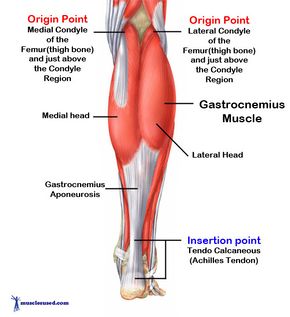Triceps Surae
Original Editor - Shejza Mino
Top Contributors - Shejza Mino, Kim Jackson and Lucinda hampton
Introduction[edit | edit source]
The triceps surae, also known as the muscle of the calf, is constructed by the soleus, the two-headed (medial & lateral) gastrocnemius and the plantaris muscles [1]. Research suggests that contracture of the triceps surae is correlated with various conditions that affect the forefoot and midfoot, therefore consideration of these muscles is valuable when evaluating and managing such conditions [2].
Anatomy[edit | edit source]
The muscles that comprise the triceps surae (gastrocnemius, soleus and plantaris) are part of the posterosuperficial compartment of the calf [1].
The soleus muscle and both heads of the gastrocnemius muscle, fuse to insert onto the calcaneus (heel bone) through the achilles tendon (also known as the calcaneal tendon). This structure is considered to be the strongest tendon in the human body [2].
It has been proposed that the plantaris muscle can also form a portion of the achilles tendon. This muscle is absent in less than 10% of the population [2].
Gastrocnemius[edit | edit source]
The gastrocnemius muscle consists of a lateral and medial head at it's origin, and make up the superficial portion of the triceps surae. Both the medial and lateral head insert into the calcaneus bone.
The gastrocnemius traverses three joints including the knee, ankle and subtalar joints [3].
Origin:[edit | edit source]
- Posterosuperior region of the corresponding femoral condyle, specifically:
- Medial head: arises from the posterior aspect of the femur, posterior to the medial supracondylar ridge and adductor tubercle. The medial head is thicker and wider than the lateral head [4].
- Lateral head: arises from the lateral aspect of the lateral femoral condyle. Proximal, we well as posterior, to the lateral epicondyle [4].
Additionally, the lateral and medial heads of the gastrocnemius muscle further attachments from the oblique popliteal ligament as well as from the posterior capsule of the knee joint.
Function[edit | edit source]
The gastrocnemius muscle produces flexion of the leg at the knee joint and plantarflexor of the foot at the talocrural joint (ankle mortise).
Further, the gastrocnemius is most effective when the knee is in an extended position and the ankle plantarflexed [4].
Soleus[edit | edit source]
The soleus muscle is situated deep to the gastrocnemius and crosses two joints including the ankle and subtalar joints [4]
Origin:[edit | edit source]
- Posterior aspect of the fibular head, medial border of the tibia (soleal line) and the interosseous membrane [4].
Function:[edit | edit source]
The soleus muscle is shown to be most effective with the ankle in plantarflexion (similar to the gastrocnemius muscle) but with the knee in flexion (opposite of the gastrocnemius) [4].
Plantaris[edit | edit source]
The plantaris muscle is made up of a small and thin muscle belly with a long and thin tendon [5]
The plantaris muscle consists of a small, thin muscle belly, and a long thin tendon that forms part of the posterosuperficial compartment of the calf
The triceps surae is innervated by the tibial nerve, nerve roots S1, S2 [1].
Function[edit | edit source]
The triceps surae forms the achilles tendon distally, and is responsible for producing the majority of ankle dorsiflexion (up to 93%) in the sagittal plane, while stabilizing the ankle complex in the transverse plane[1].
Movement performed in the sagittal plane, stabilization during locomotion (walking, running), restraining the body from falling and power jumping are all functional activities of the triceps surae [6]
Clinical Significance[edit | edit source]
Calf Strain[edit | edit source]
A calf strain implies damage to either the muscle belly itself or to its tendons at the site of attachment
Resources[edit | edit source]
- bulleted list
- x
or
- numbered list
- x
References[edit | edit source]
- ↑ 1.0 1.1 1.2 1.3 Keith LM, Arthur FD, Anne MR. Clinically oriented anatomy. Clinically oriented anatomy. 2006.
- ↑ 2.0 2.1 2.2 Dalmau-Pastor M, Fargues-Polo B, Casanova-Martínez D, Vega J, Golanó P. Anatomy of the triceps surae: a pictorial essay. Foot and ankle clinics. 2014 Dec 1;19(4):603-35.
- ↑ Cohen JC. Anatomy and biomechanical aspects of the gastrocsoleus complex. Foot and ankle clinics. 2009 Dec 1;14(4):617-26.
- ↑ 4.0 4.1 4.2 4.3 4.4 4.5 Cohen JC. Anatomy and biomechanical aspects of the gastrocsoleus complex. Foot and ankle clinics. 2009 Dec 1;14(4):617-26.
- ↑ Spina AA. The plantaris muscle: anatomy, injury, imaging, and treatment. The Journal of the Canadian Chiropractic Association. 2007 Jul;51(3):158.
- ↑ Honeine JL, Schieppati M, Gagey O, Do MC. The functional role of the triceps surae muscle during human locomotion. PloS one. 2013 Jan 16;8(1):e52943.







